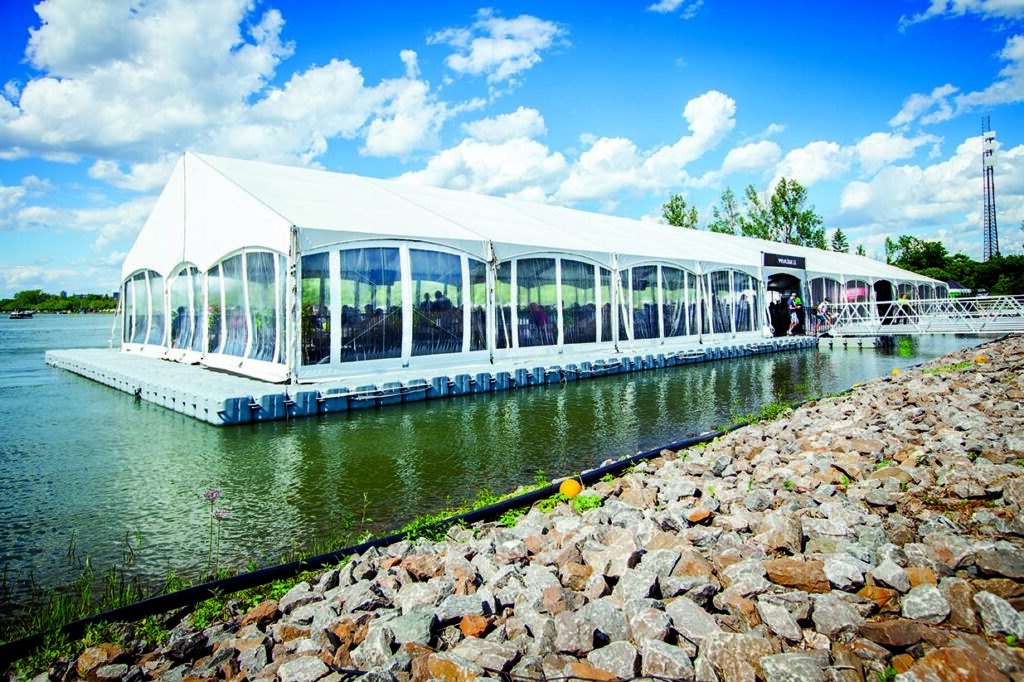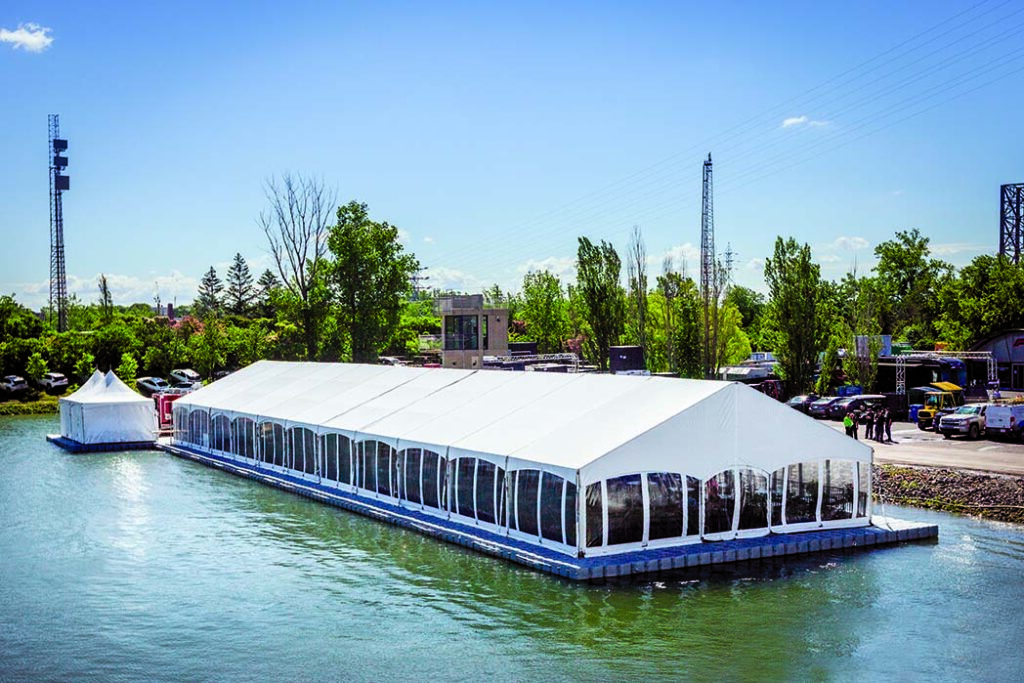Each year since 1978, the Formula One Grand Prix of Canada has taken place at the Parc Jean-Drapeau, a public park in the heart of Montreal, Que.—and for more than 40 of those years Montreal-based Fiesta Tents Ltd. has provided its tenting and flooring. The international event that takes place on the Saint Lawrence River kicks off Montreal’s summer with its biggest annual sporting event of the season, relying on more than 150,000 square feet of tenting to house VIP hospitality suites and food services, as well as sales concessions and marketing activations.

As is true for all tenting installations, the location leads the way. In this case, the 2022 Formula One Grand Prix of Canada took place, as it has since its inception, on a manmade island that is a public park owned by the city with a public beach, bike path, gardens and the Olympic rowing basin, requiring Fiesta Tents to work within a tight setup and teardown time frame and provide complex installations, all while implementing a carefully thought-out project management schedule that took into account how access affected logistics as well as the bottom line.
Over land, over water
Of the 150,000 square feet of tenting, the biggest tent Fiesta Tents installed was the corporate Elite Suite. The 65-by-770-foot clearspan structure rested on a tiered scaffolding provided by Tower Scaffold Services Inc., Etobicoke, Ont., which sat approximately 15 feet up in the air in the rear and took two days to install with a crew of approximately 20.
Another star of the tenting show housed the official caterer of the Grand Prix—Vienna, Austria-based DO & CO Catering—that provided food for all the teams. The 50-by-270-foot clearspan structure sat on a platform over the water in the Olympic rowing basin. “Although this structure sits over water, the platform it sits on is ground-supported,” explains Alexandre Renaud, president, Fiesta Tents Ltd., Saint-Laurent, Que., Canada. “But another over-water structure we provide is not.”
That floating structure housed the Privilege 12 VIP hospitality suite, operated by the event promoter, built in the water atop a temporary floating platform. “The challenge with that installation was anchoring a structure over water without using any fasteners or underwater anchor points,” Renaud says.
Indy-Co Inc. of Saint-Hubert, Que., provided the 18-by-18-inch interlocking floating dock system that provided the base for the tenting structure. “The component that allows you to interlock the blocks is strong enough to use as anchoring for guy lines, and guy out the tent to attachment points on the perimeter of the platform,” Renaud says. “We built the tent and flooring on top of that and secured it to the floating dock.”

Mastering the clock
The build typically takes between five and six weeks, and each year the biggest challenges have had to do with installation timelines and site accessibility. During setup and takedown, not only does Fiesta Tents need to coexist with citizens using the park, the crew also constantly needs to adjust the production schedule due to changing client demands, event sales and supplier interactions. “Some days, what we have in the trucks can’t be installed and we only find out once arrived on-site that morning, that we can’t proceed with the planned work,” Renaud says. “Which means we need to reorganize our day if we are going to make that time productive instead of writing the day off. This requires a tremendous capacity of adaptation, flexibility and creativity from our teams.”
When the timing changes due to the interdependence of the suppliers involved in the installation, it falls on Renaud to try to manage those setbacks so his company doesn’t incur delays for the next suppliers, “because at some point there’s a race—and that date cannot change,” he says.
To preemptively offset those kinds of inevitable challenges, Renaud and his team create a production schedule as early as possible as they gather information about the project. They set what they can “in stone,” write it up into a schedule, and fit the rest in where they can. “We break it down as per crews, per trucking so that we know where the windows of opportunity are when we can slide/fit in additional work before the event deadline,” Renaud says.
The team also builds in buffer time to allow for the unexpected. “Your instinct may be to give the client the shortest window you think you can achieve the build in, but that can come back to bite you,” Renaud says. “Because over the 40 years that we’ve done this, I don’t think there’s been a single year that things went entirely as planned.”

Allowing for access
Being conscious of how the build changes access points becomes extremely important as the installation progresses. With big events such as this one, access to the locations becomes harder and harder as more is built. “At the beginning when 10% is built, you likely have easy access throughout the site, but as the build keeps going—whether it be installations of tenting, scaffolding, etc.—you come to a point where there is limited access,” Renaud says. “And suddenly, a site that might take five minutes to access at the beginning, can take up to 45 minutes closer to the event. All that has to be factored into the schedule and billing.”
To that end, mapping helps project management, as well as communication with the client. “Having detailed mapping that shows how the build progresses, including access points that may change throughout, helps you factor timing into the schedule,” Renaud says.
For an expansive event that takes place within city limits and on public property, teardown has to happen quickly. Because the Grand Prix is held on a manmade island owned by the city of Montreal, immediately after the event, the public has to have access to their public beach, bike path, gardens and rowing training facilities that are all a part of the park. “It’s always a challenge to pull everything out on a tight deadline,” Renaud says. “But no matter what the challenges, we are proud of our ability to deliver on new installation and deadline requirements, custom projects and last-minute solutions to challenging demands—year in and year out for more than 40 years.”
Sigrid Tornquist is a Minneapolis, Minn.-based writer and editor, and a former InTents editor.
Event collaborators
The event: Formula 1 Grand Prix of Canada
The venue: Parc Jean-Drapeau, Montreal, Que., Canada
The structures: Fiesta Tents Ltd., Saint-Laurent, Que., Canada
The scaffolding: Tower Scaffold Services Inc., Etobicoke, Ont., Canada
The catering: DO & CO Catering, Vienna, Austria
The floating platforms: Indy-Co Inc., Saint-Hubert, Que., Canada
 TEXTILES.ORG
TEXTILES.ORG


